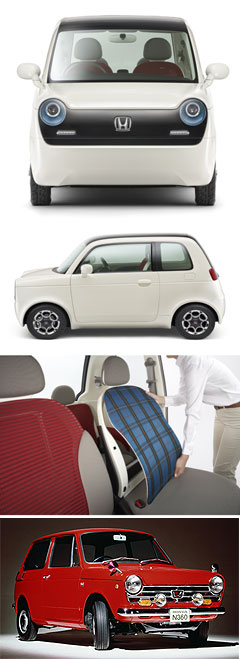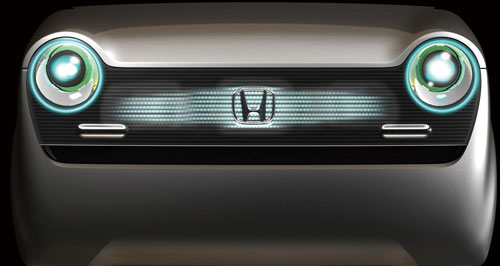Make / Model Search
Future models - Honda - EV-NFirst look: Born-again Scamp from HondaOh baby: The 21st century Scamp from Honda, the EV-N concept, has electric power in place of the 1960s original's twin-cylinder air-cooled engine that could spin - motorcycle style - to 9000rpm. Honda’s original baby car makes comeback as electric commuter concept1 Oct 2009 FIRST there was the New Beetle from Volkswagen, then the born-again Mini, followed by the new-age Fiat 500. Now Honda has ventured deep into nostalgia for inspiration at this year’s Tokyo motor show, bringing back a 21st century concept version of its first hatchback, the mini N360 Scamp, this time called the EV-N. As its title suggests, the EV-N is a plug-in battery-powered electric vehicle, with the ‘N’ in the title presumably a nod to the ‘N’ of N360. However, Honda is saying precious little else officially about the technology of the new four-seat baby concept car, which will be shown with a series of environmentally friendly vehicles in an area of its stand dubbed HELLO (Honda Electric mobility Loop). These vehicles include Honda’s FCX Clarity hydrogen fuel-cell electric vehicle, the EV-Cub electric motorcycle – again drawing on inspiration from the original Super Cub step-through motorcycle – a cart-like ‘electric personal mobility device’ called the EV-Monpal and – strangest of all – the U3-X, a one-wheel personal mobility device that uses balance control technology developed through the ASIMO robot project. The latter - a sort of electric unicycle - can even be stored in a made-to-measure cavity in the door of the EV-N. In the current trend, solar cells cover the roof to top up the battery. And while specifics of the EV-N's battery and electric motor technology will remain a mystery until the show opens, there is no doubting the EV-N’s bloodlines, with the same sawn-off styling cues as the original N360, front and rear, with a few modern tweaks.  Left: Honda EV-N concept. Bottom: The original N360 Scamp. Left: Honda EV-N concept. Bottom: The original N360 Scamp.The round headlights moulded into the front fenders are hallmarks of the original. The EV-N's seats are upholstered with a single sheet of material – deck-chair style – presumably for light weight and compactness. Pictures of the car released by Honda show the seat ‘covers’ being switched – apparently to suit the mood of the day. In a totally modern touch, the ‘grille’ of the EV-N lights up in an LED-induced electric blue hue – an attractive but seemingly wasteful use of electricity in a battery car and a feature that is unlikely to make it into production any time soon. The original N360 – known as the Scamp in Australia – made its debut 1967 and lasted in production for three years, replaced by the bigger N600. The original engine was an air-cooled 354cc 23kW twin cylinder, using tried and trusted technology from Honda motorcycles - and revved similarly, being capable of revving to an astonishing 9000rpm. Driving through the front wheels, the Scamp even offered an automatic transmission – the Hondamatic – becoming the first Japanese ‘kei’ car to do so. Noisy and rather agricultural, the N360 was nevertheless extremely fuel efficient and cheap. While it was Honda’s first hatchback, it was not the Japanese company’s first Honda four-wheel vehicle – that title belongs to the T360 mini truck of 1963. Nor was the Scamp Honda’s first passenger car – that was the 1964 chain-driven S600 sportscar, which used the same four-cylinder engine as the T-Series truck. Along with the S600 (and later S800), the N360/Scamp established Honda as a car-maker around the world, particularly in Australia where it developed a reputation as a worthy commuter. Many Scamp owners later stepped up to the Honda Z and then the Civic as the company expanded its range and technical know-how. Whether the EV-N will make it into production, only Honda knows.  Read moreAll future modelsMotor industry news |
Click to shareHonda modelsResearch Honda All future modelsMotor industry news |


 Alfa Romeo
Alfa Romeo Abarth
Abarth Audi
Audi Aston Martin
Aston Martin BMW
BMW Bentley
Bentley Ferrari
Ferrari Chevrolet
Chevrolet Ford
Ford Fiat
Fiat GWM
GWM Foton
Foton Hyundai
Hyundai Honda
Honda Jaguar
Jaguar Isuzu
Isuzu Kia
Kia Jeep
Jeep Land Rover
Land Rover Lamborghini
Lamborghini Maserati
Maserati Lexus
Lexus McLaren
McLaren Mazda
Mazda Mercedes-Benz
Mercedes-Benz Mitsubishi
Mitsubishi Mini
Mini Peugeot
Peugeot Nissan
Nissan Ram
Ram Porsche
Porsche Rolls-Royce
Rolls-Royce Smart
Smart Skoda
Skoda Suzuki
Suzuki Subaru
Subaru Toyota
Toyota Tesla
Tesla Volvo
Volvo Zeekr
Zeekr







Facebook Twitter Instagram